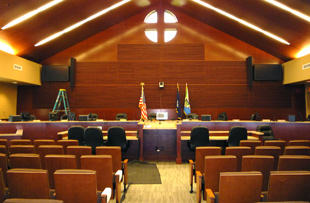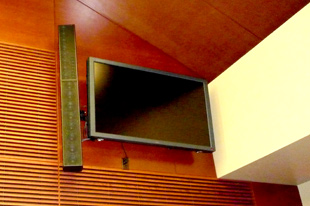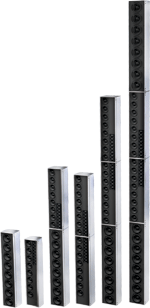![]() An industrial crossroads on the north shore of Louisiana’s Lake Pontchartrain, Slidell has weathered its share of storms – but nothing like the devastation brought by Hurricane Katrina in 2005.
An industrial crossroads on the north shore of Louisiana’s Lake Pontchartrain, Slidell has weathered its share of storms – but nothing like the devastation brought by Hurricane Katrina in 2005.
For a community that is still in recovery, the completion of the US$5.4m Slidell City Council and Administrative Center is both a return to its past running and a sign of good things to come...
For the employees who moved into offices here in mid 2010 – many who had been working out of trailers in a complex off nearby Bayou Lane since Katrina – the opening of the facility in Slidell’s Olde Towne area represents a welcome change. But the 32,970-sq-ft space was designed with far more than just employee comfort in mind...
 The building, explains Slidell City Council Administrator, Thomas Reeves, is completely new – a replacement for the facility catastrophically damaged by Katrina. Designed by Sizeler Thompson Brown Architects of New Orleans, and built by FH Meyers Construction, the facility houses municipal government departments and incorporates a series of metal vents alongside the walls to allow water to drain out in the event of future flooding.
The building, explains Slidell City Council Administrator, Thomas Reeves, is completely new – a replacement for the facility catastrophically damaged by Katrina. Designed by Sizeler Thompson Brown Architects of New Orleans, and built by FH Meyers Construction, the facility houses municipal government departments and incorporates a series of metal vents alongside the walls to allow water to drain out in the event of future flooding.
‘The area we occupied was five feet underwater, so city hall and all the buildings down here were damaged.’
The restoration of the Olde Town is ongoing, says Reeves. Currently the city is in the process of building a US$7m auditorium nearby, which is presently 12-to-18 months from completion.
‘The actual office space only occupies about 22,000-sq-ft – 33,000 if you count the first floor,’ Reeves explains. ‘But there’s a foyer and an elevator there and that’s about it.’ The design is intended to ensure that they won’t have to rebuild from the ground up should another storm similar to Katrina strike: ‘This building is wind rated to 140mph and we raised it eight feet, so we shouldn’t have a problem with another disaster of that type.’
While the building serves a variety of functions, one of its most technologically advanced spaces is the city council chamber proper, which incorporates audiovisual and electronic voting systems designed by NB Traylor and Associates, and installed by Interstate Electronic Systems.
Installing the A/V...
Among other duties, it was Reeves’ role to assist the council in the selection of an A/V system for their council chambers. Design began in the spring of 2009 and went out to tender later that year. Although the building opened in March 2010, installation of the systems for the council chamber proper cintinued throughout April and May.
 The Council meets twice a month, says Reeves, and meetings are filmed and rebroadcast on a local government-access cable channel. ‘We were looking for a quality recording system integrated with an electronic voting system.’ In addition, the roughly 2,500-sq-ft room required a rock-solid sound system. Although typically used by roughly 60 people, the room’s total capacity is double that, and because of the nature of the space, quality speech reinforcement and aesthetics were both highly important.
The Council meets twice a month, says Reeves, and meetings are filmed and rebroadcast on a local government-access cable channel. ‘We were looking for a quality recording system integrated with an electronic voting system.’ In addition, the roughly 2,500-sq-ft room required a rock-solid sound system. Although typically used by roughly 60 people, the room’s total capacity is double that, and because of the nature of the space, quality speech reinforcement and aesthetics were both highly important.
To ensure the systems inhabiting the chambers met the council’s specific needs, engineering consulting firm NB Traylor and Associates was called on to take care of design, post construction. Its role in the project, says company president and system designer Trez Traylor, was in part a function of an ongoing relationship with the architects of record, but also of the fact that they have more than 40 years of expertise in providing special systems for a variety of needs, including telecommunications, security and theatrical applications.
‘My father started this company in the late sixties, back when special systems consulting was a much simpler animal than it is today.’ And while the audio system for the room didn’t need to be terribly complex, he explains, it did have to speak to some very specific challenges. First, the room’s vaulted ceiling made placement of loudspeakers difficult.
‘We were forced to put the speakers behind the dais where the council sits, which put the mics right in the line of fire,’ says Traylor. ‘So what didn’t look like a special situation – initially – quickly evolved into that.’
...and the sound
This was the primary requirement Tannoy’s QFlex arrays addressed: ‘We know that line arrays have better characteristics for handling that than a point source speaker. We needed to maintain coverage of the room, but keep it off the ceiling.’ While Traylor has used QFlex before, the company typically co-specifies equivalent products for the public projects they take on. In this case, the Tannoy QFlex won out.
 ‘The council dais seats nine members,’ says Ray Rideau, managing partner and general manager of IES. ‘There is a secretary position to the left of the dais with administration seating in front of the dais. The client’s mandate was to have the best sound coverage before feedback while maintaining the room’s aesthetics’.
‘The council dais seats nine members,’ says Ray Rideau, managing partner and general manager of IES. ‘There is a secretary position to the left of the dais with administration seating in front of the dais. The client’s mandate was to have the best sound coverage before feedback while maintaining the room’s aesthetics’.
The design of the chamber is sleek, functional and modern, but with a degree of warmth provided by dark wooden slats covering the wall behind the dais and the overall understated décor in the room.
‘They have woodwork that covers the whole back wall, so the speakers had to be black. They had to blend in with the NEC displays next to them.’ IES has also installed a number of electronic voting and A/V recording systems for similar applications in the area.
Interstate Electronic Systems was formed in 2003 by principals, Lloyd Francioni, Michael Rideau and Raymond Rideau. One of the primary values they provide to customers, with 90-plus years of combined experience in the A/V and electronic security system industry, is the emphasis they place on detail and care in both their designs and installations. Rideau and Reeves have become friends over the course of the project, says Rideau; in part, as a result of the personal touch and interest IES takes in its work. ‘Our customer retention is very high. They like us. They stay with us.’
While reacting to NB Traylor and Associates’ design in this case, IES also specifies Tannoy regularly in its own designs, Rideau says, referencing another project elsewhere in the area where another Tannoy-based distributed audio system is to be installed.
‘I could see why they chose it. The room is very wide, and with the 110° dispersion on each side, you can cover that room pretty good. We tilted the speaker in a bit instead of facing out – so you can get that coverage all over and take that vertical beam and go down to 10° – to overshoot people and get sound to the back.’
Placed roughly equidistant from the floor of the dais and the peak of the ceiling – approximately 14 feet above the main floor – they provide maximum intelligibility to an area at the rear of the chamber where a number of seats are located beneath an overhang, and where the vaulted ceiling terminates, dropping down to a height of approximately eight feet.
The Tannoy arrays also blend in seamlessly with two 57-inch NEC wall-mounted LCD monitors, which show voting results to those in attendance and are placed between each QFlex 24 and the chamber’s walls behind the dais.
In controlFor video recording/broadcast of the meetings, three Sony BRC-Z700 Cameras using the Vaddio Wall Pan/Tilt/Zoom Camera CCU System are located in the room; one behind the dais and two in front, tied into a Vaddio production switcher/controller. A number of Vaddio Pre View HD dual and triple LCD monitors are located on both the dais and the administration desks for the use of participants. The system also incorporates 15 Audio-Technica ES915C21 gooseneck microphones, AMX NXT-1700VG touchscreen controls and AMX M10 touchpads for voting and video selection, as well as AMX presentation generator and AMX NSS-Vote voting software.
To the rear of the room – in the left-hand corner – there is a control room from which video production is managed and where a variety of other system elements are housed, including a Tascam CD player, Tannoy 8001 4150 Vnet USB/RS232 interface, a Fostex rack-mount audio monitor, Sony HVR-M35U Recorder and Biamp Nexia CS DSPs.
‘The Biamp’s are used primarily for distribution, explains Rideau. ‘As a matrix, because we had to feed some A/V information back to the dais for council member’s monitors, instead of using the DSP in the Biamp we do everything within the QFlex.’ The result, particularly in terms of even coverage, he adds, is impressive: ‘When we finished it was incredible. You could walk that whole room and there was not even a half a dB ofdifference in SPL throughout.’
For his part, Reeves is even more enthusiastic – partly owing to the fact that the completion of the building enables he and others working in Slidell to get back to something approaching pre-Katrina normalcy, but also with the quality of sound in the room. ‘We have fifteen microphones between the audience and speakers, but it sounds awesome. Tannoy had an engineer come in and spend a day getting it just right for our room and it’s just excellent. We would use these again if a similar situation came up.’
More: www.tannoy.com
More: www.biamp.com
More: www.amx.com